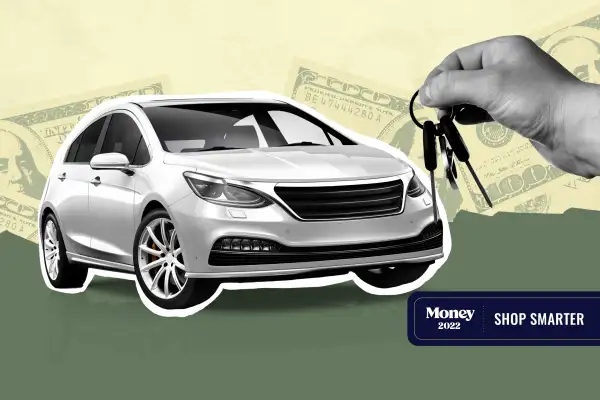How to Buy a Car in 2022

This article is part of Money's January 2022 digital cover, which features 22 ways to make 2022 the best money year of your life. Browse all 22 articles here. A updated version of this article is available here.
The most frustrating part of buying a car has traditionally been tense negotiations at the dealership. Lately, buyers should consider themselves lucky if they can even find a car worth haggling over.
Spiking demand, manufacturing slowdowns and supply chain problems have hit the auto market particularly hard during the pandemic, and the results are slim pickings and soaring prices for anything with four wheels.
Buyers accustomed to scooping up bargains on used cars have been hit with sticker shock, with the average price now topping $29,000, up 28% year over year according to data analyzed by Edmunds. New cars are in short supply — in September, inventory was down 60% compared to the same month in 2020 — and super expensive, with the average vehicle going for $45,872 in November, or $662 over the manufacturer's suggested retail price (MSRP). That's up from $39,984 just 12 months prior, when the average car sold at a discount of $2,123 off the sticker price.
Understandably, many would-be buyers have been holding off on picking up a new set of wheels. But experts don't see the supply of new vehicles bouncing back to pre-pandemic figures until at least 2023, and it's likely to take even longer before it feels like a buyer's market for used cars again.
"There are so many unknowns, it's just impossible to predict when things will get back to normal," says Jenni Newman, editor-in-chief of Cars.com.
For the moment, the best approach is one that buyers don't want to hear: "Wait as long as possible," says Ivan Drury, senior manager of insights at Edmunds. "Things will only get better."
If that’s not feasible, here are some strategies to help you get the car (and price) you want … or at least something you can live with.
Do your research and be flexible.
It's more important than ever to narrow your list of "must-haves." Be willing to compromise on the trim level and features, and maybe the manufacturer and model as well. Even if you always buy used, consider new — there may not be that big of a price difference. But beware: certain hot models are commanding huge premiums — some Ford Broncos are selling for $40,000 over sticker price — so it's best to be open to alternatives.
"Figure out your dream car, then have a backup and another backup," says Cars.com's Newman. "Definitely be flexible on things like color."
It's wise to expand your search to sellers far away from home too. "You can't just look in the 10- to 25-mile radius," says Newman. "Think 50 miles, 100 miles."
Be prepared to act quickly.
No matter how good of a negotiator you are, it's basically impossible to dicker your way to a sweet deal comparable to pre-pandemic times.
"I don't care what kind of car you're looking at, new or used, premium or not, buying a car is basically a luxury purchase nowadays," says Drury from Edmunds.
Forget the classic strategies like waiting for sales or big incentives tied to major holidays, which are all but nonexistent now. Same goes for tactics like walking away from the salesperson's offer, knowing they'll call later with a better price, or emailing a bunch of dealerships and letting their internet sales units compete for your business. Dealerships know they hold all the cards (er, cars), and are confident that if you don't bite at the price they want, another buyer will be along shortly. J.D. Power reports that at the end of 2021, the average car was in a dealership's possession for only 17 days before it was sold, compared to roughly 70 days before the pandemic.
With all that in mind, Drury says you should car shop fully prepared to buy. Make sure your vehicle priorities are set, your financing is in order and a down payment is readily available.
Negotiate at the margins.
While dealerships aren't likely to budge on price, car shoppers might have luck asking for bonus extended warranty coverage, free oil changes and the like.
"It's always worth considering financing through the dealer," as well, says Newman, since the dealership profits on those loans and may have some room to negotiate. Just be sure to check with your bank or another preferred lender first — they might offer even better terms.
Maximize the only bargaining chip you have.
Remember: There is a supply crunch. So if you have a car to sell or trade in, you are in possession of a highly in-demand asset that's probably worth more than you think. Make the most of it! The average trade-in in November was worth roughly $23,000; up an astonishing 50% year over year.
Before agreeing to a dealership's trade-in offer, shop the vehicle around to ensure you're getting a fair price. "If I have a Ford to trade in, I'd go to a Ford dealership and see what they'd pay to buy it outright," says Newman. Ask some local used car lots to make you offers as well. Selling the vehicle may seem like more of a hassle than using it as a trade-in, but you could wind up with hundreds or even thousands of dollars more by taking that extra step.
Be sure to drive home a car you actually want.
Car sellers have designed the buying experience to be confusing and full of pressure, and pandemic-related complications have only made things worse.
The nightmare scenario is that you want a car so badly you wind up with something that’s impractical, uncomfortable or otherwise doesn't fit your needs — and, like everyone else in today's wild market, you overpay in the process.
To avoid that situation, take a step back and consider custom ordering the exact model and features you want. It'll require patience — many buyers are waiting four months for orders to be fulfilled, with delivery dates pushed back multiple times — and you can expect to pay the MSRP or higher. But at least you'll be getting the vehicle of your choice.
More from Money:
Is the Housing Market Finally Cooling? A Guide to Home Buying This Winter
10 Items You Should Start Buying in Bulk
The Best Deals Around Are in Your Local ‘Buy Nothing’ Facebook Group

